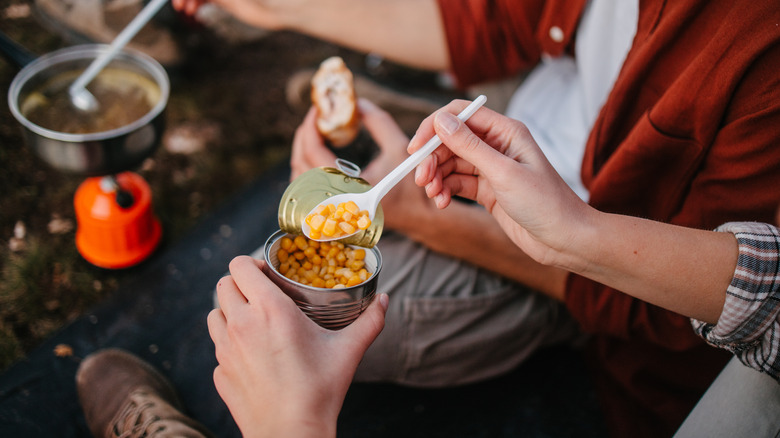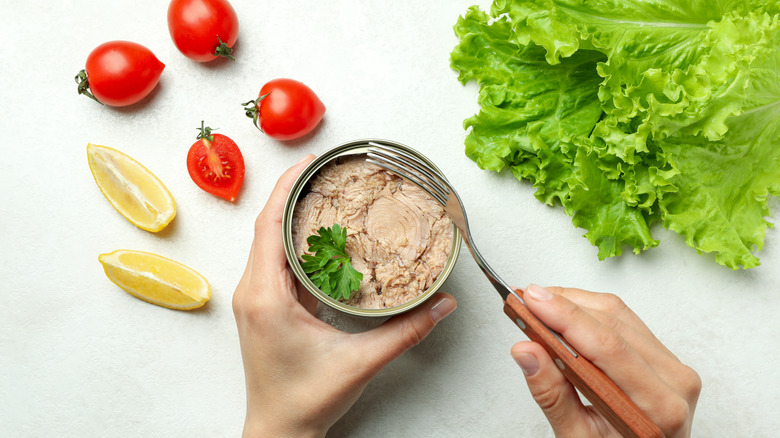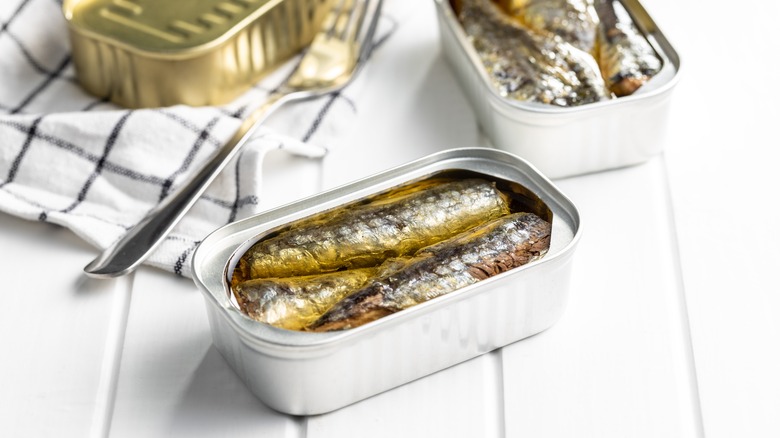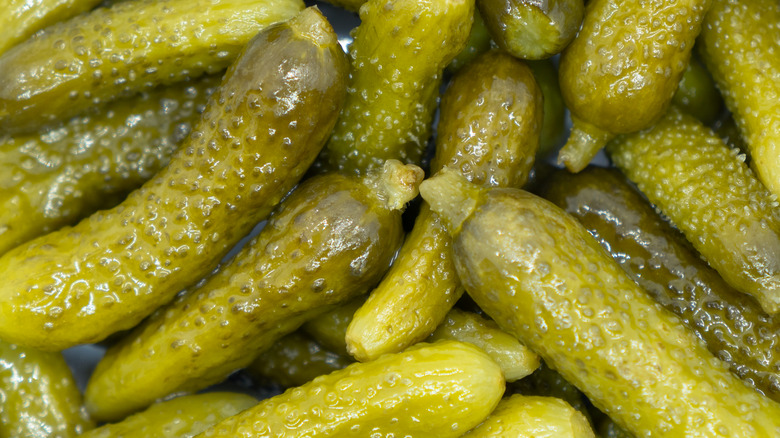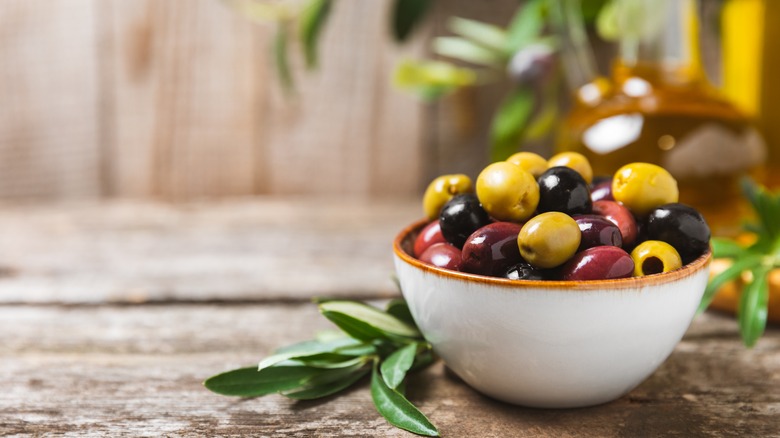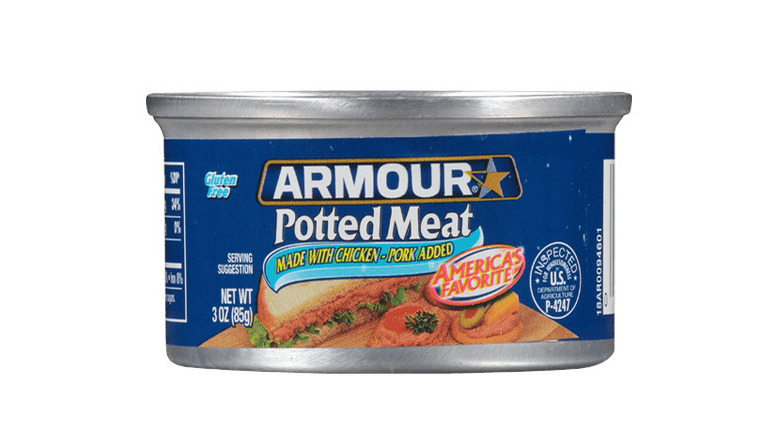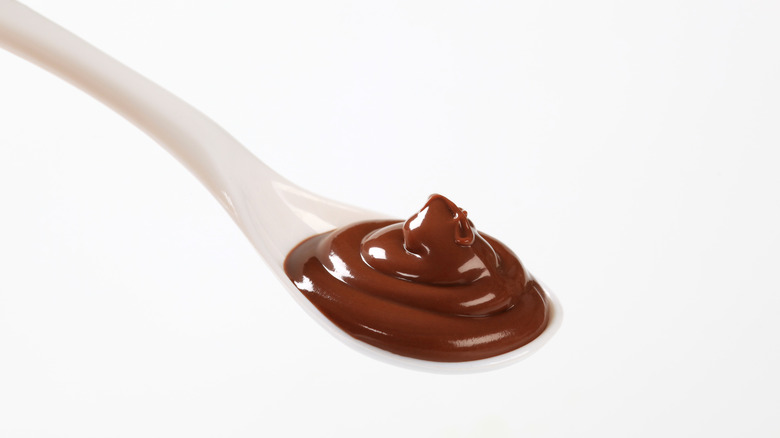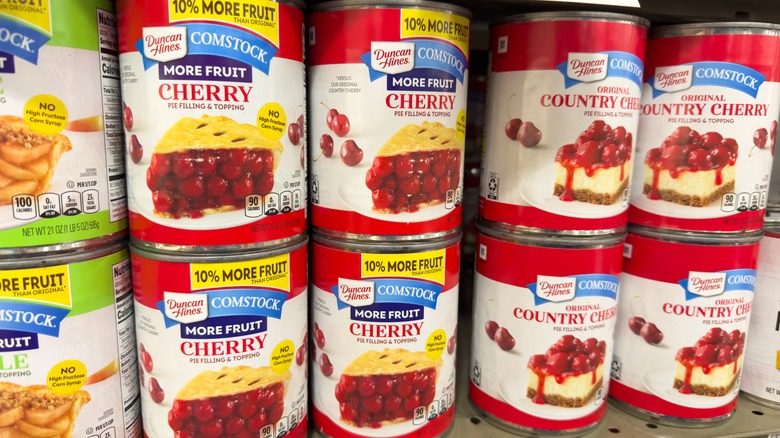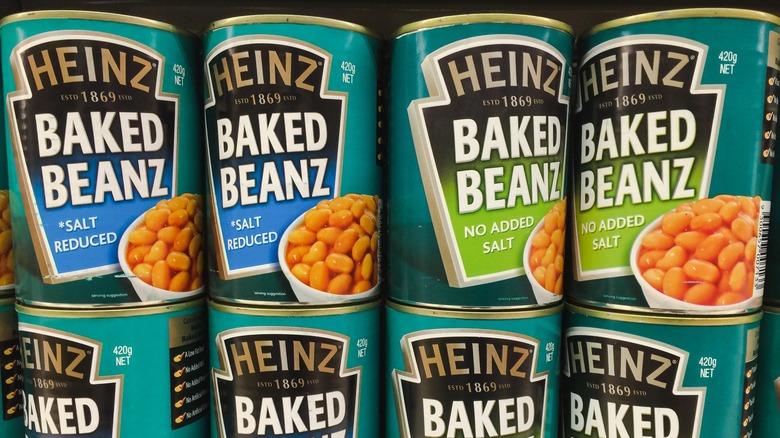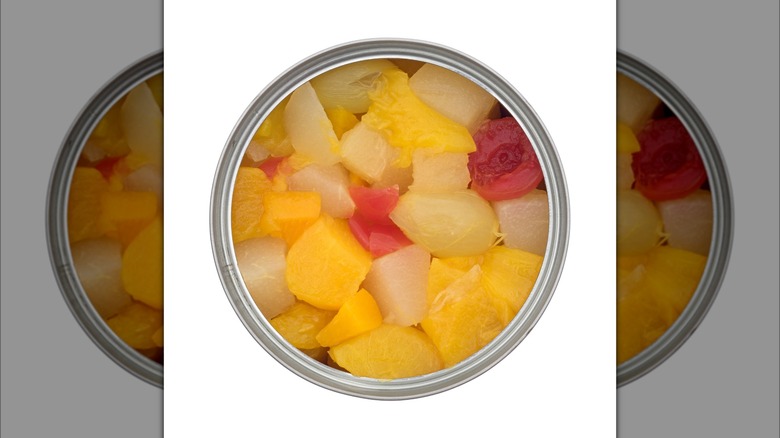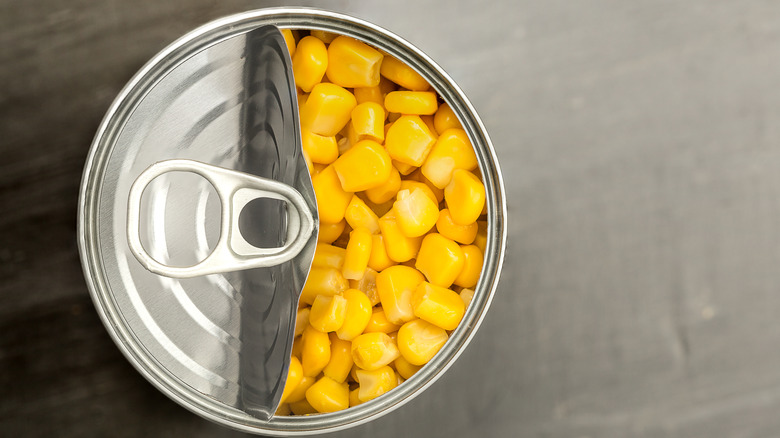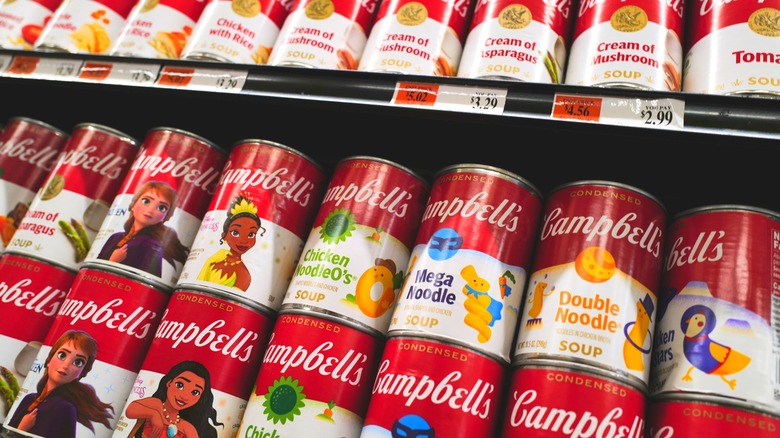The Most Delicious Foods To Eat Straight From The Can
Do you ever have one of those nights where you just can't muster up the will to cook dinner, and even turning on the stove seems like too big an expenditure of energy? If so, you'll be happy to learn that there are several foods you can eat straight from the can, no stove-starting necessary.
You've surely seen the old movies where cowboys eat beans straight out of the can, but you have way more options than that. Canned vegetables, canned tuna, canned soup — you can eat lots of delicious things from a can without heating them up first! And these foods aren't just great for when you're having a lazy day. They can also be a lifesaver when your electricity goes out and you can't use your appliances to warm up your meals, or when you go on a camping trip and don't have the tools to start a fire.
But which canned foods should you keep on hand for this purpose? In terms of safety, almost all canned food is just fine to eat as-is, as long as you keep an eye out for tell-tale signs of canned food spoilage. Canned goods are heated up to a high temperature during the canning process to kill any bacteria inside, and are then tested for toxicity in a lab. However, safety aside, there are some foods that are just tastier than others when it comes to eating them cold, so we have compiled a big list of the best ones.
Tuna
Whether you get it from a can, fresh, or as a part of your sushi platter, tuna is one of the most-eaten fish in the world. Canned tuna is especially popular because it is just so convenient. It is cooked before it is canned, so it is safe to eat without heating and can be stored for two to five years or longer without going bad.
Canned tuna is so good that many people regularly eat it straight out of the can with a fork, but many others prefer to make a tuna salad spread with some mayonnaise that can go in sandwiches or on top of crackers. It can also bring some heartiness to your salads, or can be sprinkled into already-cooked dishes like scrambled eggs to bulk them up.
Tuna's benefits aren't just limited to taste and convenience, however. It is also a delicious way to get high-quality protein and taurine, an amino acid that can help protect against heart disease. It is low in fat too. For those looking for particularly healthy or particularly tasty tuna, canned tuna comes packed in either oil or water, the latter of which has fewer calories, and the former of which has a richer flavor.
Sardines
Like tuna, sardines can be eaten straight from the can. You can eat them on their own, or you can add them to things like salads, cold rice dishes, sandwiches, or crackers. They also make a quick and easy addition to hors d'oeuvre platters and a delicious topping for toast, which helps tone down their saltiness.
Also like tuna, sardines are actually pretty healthy for you. They are high in nutrients, including calcium, B vitamins, iron, and omega-3 fatty acids. They are also just plain convenient. While you should always drain them before eating, these small fish can be eaten in a bite or two, bones and all. Those who think that sounds a bit gross can find cans of sardines that are both skinless and boneless, but for those with a stronger stomach, you should note that sardines' skin and bones are soft and edible, and often barely even noticeable when eating. They also raise the level of calcium you're consuming, so it's worth giving them a try.
Pickles
Okay, technically pickles come in a glass jar and not a "can," but that's only because canning pickles in a metal container would cause a detrimental chemical reaction with the salt and acids in the brine. Regardless, pickles can be stored for a long time thanks to their preservation process, which involves brining cucumbers in a mixture of salt, vinegar, and seasonings.
Once opened, pickles should be stored in the refrigerator, but whether they are being opened for the first time or the tenth, you can eat them right out of the jar. They make a crisp, delicious snack on their own (especially the big, juicy ones, the pickle spears, or the sweet gherkins), and come in many different varieties like dill, sweet, and even spicy pickles. Pickles also make the perfect topping for burgers and nice, tangy additions to salads or appetizer dishes.
But wait, that's not all! We have been discussing pickled cucumbers there, but there are many other pickled vegetables out there that can be eaten straight from the jar as well. The list includes, but is not limited to, pickled eggplants, pickled artichoke, pickled carrots, pickled cauliflower, or even pickled okra.
Olives
Just like pickles, olives are typically stored in brine in a jar. This makes them ideal to eat straight from the container, as the liquid they are stored in brings an added pop of salty goodness. The most common types of olives are green, which taste a bit more bitter because they are harvested before they are ripe, and black, which are less bitter and tend to absorb more of the taste of the brine that preserves them.
Whichever color or flavor you prefer, you can eat olives as-is as an appetizer or snack — many hors d'oeuvre platters feature plain olives on toothpicks — or you can chop them up and put them in salads or incorporated into sandwiches with other cold items like tuna. For an even simpler-but-still-tasty snack, you can slice them and eat them on triangles of toasted bread. For a more complex one, you can use a food processor to blend olives, olive oil, capers, lemon juice, and garlic together to make olive tapenade, or make a marinade with olives, feta cheese, garlic, red pepper flakes and olive oil, which you then let rest for an hour before serving on bread or as a part of a larger meal.
Potted meat
Potted meat is most often used like a sandwich spread or on crackers, but what exactly is this soft, seemingly immortal mystery meat? Back in the day (as in, the early 19th century), meats like chicken, pork, and beef were cooked and seasoned, then packed into jars based on meat type. The rest of the jar was then filled up with liquid animal fat, then sealed. While this did keep bacteria from getting in, it wasn't the most efficient way to do things. The invention of modern canning in the early 1800s changed the game for potted meat.
Nowadays, potted meat is almost always a mixture of many different types and cuts of meat pureed into a paste and canned using standard preservation practices. Usually, it is made with many of the meat parts that are often thrown away, like organs and feet, which is good for the environment since nothing goes to waste. While it might not sound very appetizing to some, there are many people who swear that this meat is as tasty as it is convenient — which must be true, seeing as there are several companies like Armour Star that have been in the potted meat business for more than a century with no signs of stopping.
Pudding
Pudding doesn't always come in little plastic cups or as a powdered mix. Sometimes, it comes in very large cans, much to the delight of the prepper community. So-called #10 cans of pudding are shelf-stable and ready to eat right out of the enormous can. Because, you know, you can't prep for an apocalypse or societal collapse without some dessert.
These cans of pudding come in flavors like vanilla and chocolate, and have a relatively simple list of ingredients. They contain non-fat milk, water, vegetable oil, sugar, modified food starch, salt, flavors both natural and artificial, and a few other odds and ends like yellow food coloring. These cans and their contents are designed to last for years in storage, and are much more convenient than the pudding mixes, as they don't require anything but a spoon and, if you want to be fancy, a bowl. Since these particular cans are often sold in bulk and for long-term storage, you can often buy many cans at a time, so you'll be stocked up on pudding for years.
Pie filling
Have you ever thought that the crust of a pie was just holding you back from fully enjoying that sweet, scrumptious pie filling you love? Well, we have news for you: You don't need that pesky pie crust anymore! You can eat your pie filling straight from the can.
Whether you prefer apple, blueberry, cherry, or peach, pie fillings are already cooked, and thus completely safe to eat exactly as they are. Most of them already have spices and flavorings like cinnamon added, but you can add your own if you like. And if you haven't already run off to grab a spoon, there are also some other fantastic things you can do with canned pie filling without cooking it. You can, for example, use cherry pie filling as a topping for an unbaked cheesecake. Or you could use apple or peach pie filling as a topping (or a base) for vanilla ice cream alone or with a crumble topping. You could also serve it on top of graham crackers for a quick but elegant little snack, but that might be coming too close to a crust for some pie filling purists.
Beans
It is impossible to get through a list of foods you can eat straight out of the can without mentioning this favorite dinner of John Wayne and other real and fictional cowboys. Canned beans are beans that have already been cooked, making them perfect for many reasons. For one thing, cooking fresh or dried shell beans takes a long time — we're talking hours and hours, and that's after an all-night soak. And for another, who doesn't want to feel like Butch Cassidy or the Sundance Kid as they pop open a can of beans and eat them around a campfire out in the "wild?"
There is one thing to keep in mind before you embrace your inner Rooster Cogburn, however. Canned beans have been blanched and sealed, then cooked at high temperatures to make them safe for storage for a long time. However, salt and other additives are also included in those cans, so it's better to rinse those beans before tucking in. Eating beans from a bowl instead of a tin can might put a bit of a damper on your idyllic cowboy fantasy, but we're sure Mr. Wayne won't mind.
Fruit cocktail
While many of the other foods on this list fall under the "you can eat them straight from the can, but they are usually warmed up" category, fruit cocktail has always been made for the express purpose of eating straight from the can (or poured into a bowl). The fruit inside has been preserved so that it can last a long time on the shelf or in your pantry without losing its fresh, juicy flavor.
There are many different varieties of fruit cocktail, such as fruit cocktail in heavy syrup, which is a favorite of those with a sweet tooth, "no sugar added" fruit cocktails, which rely only on the sweetness of the fruits inside for flavor, fruit cocktail in 100% juice, which contains fruit juice instead of a sugar syrup to preserve the fruit, and "fruit cocktail lite," which contains a less sugary type of syrup than the heavy kind. Most fruit cocktail cans contain pears, peaches, cherries, grapes, and pineapples, but even that varies based on brand and type. So basically, whatever kind of fruit tickles your fancy, you can find it in a fruit cocktail can, ready to eat — no fruit washing or cutting necessary.
Corn
Everybody loves corn. It is a popular side dish because its flavor is neutral enough to work well with almost any kind of meat or fish entrée, but it still has a lovely, sweet, buttery flavor of its own. Many people don't realize, however, that canned corn doesn't need to be cooked to be eaten. This corn has already been heated to a safe temperature during the canning process (like all other canned goods), so if you wanted to, you could simply pop open the top of that metal can and dig in.
There is a "but" to this, though. Some corn comes packed in very salty water, so it's best to drain it before eating, just like with canned beans.
Once that is done, you can eat the corn as-is or add it, uncooked, to tacos, rice dishes, salsas, and guacamoles, or mix it with other vegetables to create a corn salad. Fun fact: While corn may taste sweet, it doesn't actually add any much sugar to your dishes. Its moderate glycemic index ensures that the carbohydrates it releases as it breaks down enter your blood slowly, not all at once. This is good news for those with diabetes, because it means that it shouldn't cause any blood sugar spikes.
Soup
This is a hotly (or room temperature?) debated topic among canned soup lovers. Some say that canned soup is just as delicious straight from the can as it is heated up on the stove, while others say this is tantamount to sacrilege. The latter say it isn't even safe to eat soup straight from the can, but this isn't necessarily true. Many canned soups are perfectly safe to consume without heating because they have already been heated during the canning process.
Before you grab a spoon and dig in, however, make sure to read the label on the can. While some soup is ready to eat, canned soups labeled "condensed" are not. These soups are not really soup as we know it quite yet, as they are very thick and concentrated. They require the addition of water or, in some cases, milk to make them a true, liquid soup, and in order to dilute the concentrated salt and additional flavors they contain.
